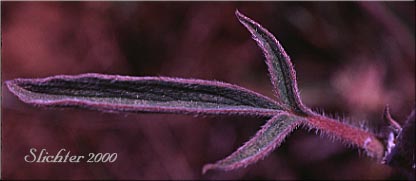Varileaf phacelia is a biennial or short-lived perennial plant with a slender taproot and a single erect, stout stem from 20-120 cm high or surrounded at the base by several lesser stems. The herbage is grayish-green with short, often bristly hairs. The leaves are prominently-veined with long petioles on the lower leaves and the stem leaves with shorter stems. One or two pairs of leaflets or lobes may be found at the base of each leaf although a few leaves may be entire margined. These leaflets are always smaller than the elliptical leaf blade.
The numerous inflorescences are curled cymes which are densely bristly and which contain dull whitish to purplish flowers with filaments which are much longer than the corolla which is approximately 3-6 mm long and wide
Varileaf phacelia may be found on dry, open, rocky slopes at lower elevations to moderate elevation in the mountains.
Varileaf phacelia may be found from southern British Columbia south to central California and east to Montana, Arizona, and New Mexico.
In the Columbia River Gorge, it may be found from near the west end of the gorge east to about Horsethief Butte State Park between the elevations of 100'-4800'.
